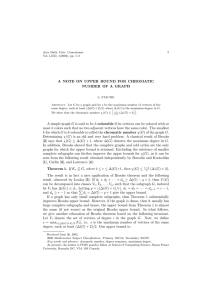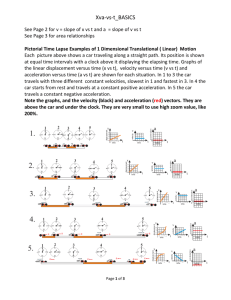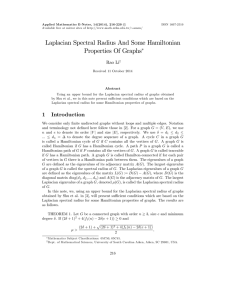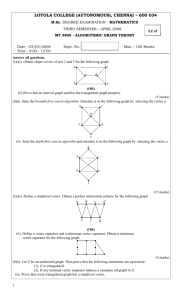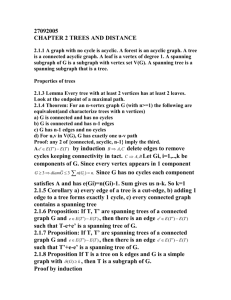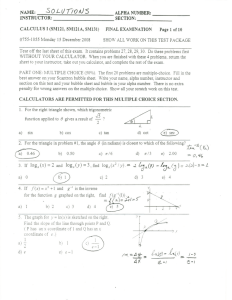SHARP UPPER BOUNDS ON THE SPECTRAL RADIUS OF THE LAPLACIAN... OF GRAPHS
advertisement
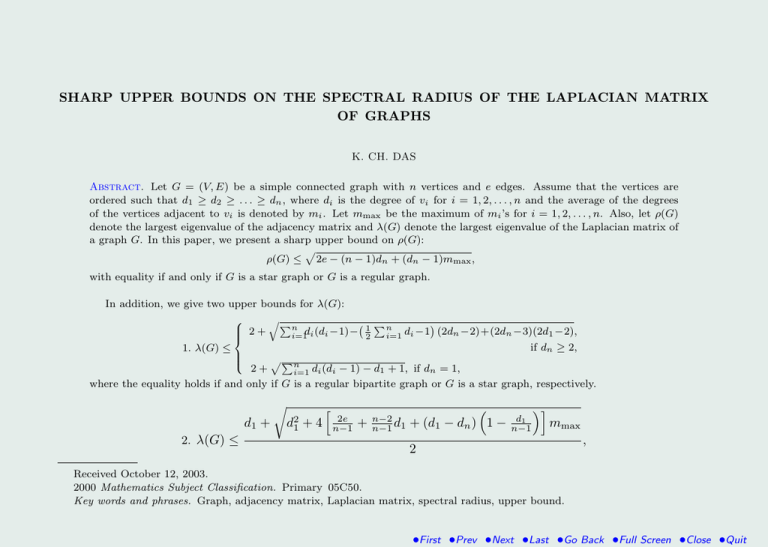
SHARP UPPER BOUNDS ON THE SPECTRAL RADIUS OF THE LAPLACIAN MATRIX
OF GRAPHS
K. CH. DAS
Abstract. Let G = (V, E) be a simple connected graph with n vertices and e edges. Assume that the vertices are
ordered such that d1 ≥ d2 ≥ . . . ≥ dn , where di is the degree of vi for i = 1, 2, . . . , n and the average of the degrees
of the vertices adjacent to vi is denoted by mi . Let mmax be the maximum of mi ’s for i = 1, 2, . . . , n. Also, let ρ(G)
denote the largest eigenvalue of the adjacency matrix and λ(G) denote the largest eigenvalue of the Laplacian matrix of
a graph G. In this paper, we present a sharp upper bound on ρ(G):
p
ρ(G) ≤ 2e − (n − 1)dn + (dn − 1)mmax ,
with equality if and only if G is a star graph or G is a regular graph.
In addition, we give two upper bounds for λ(G):
qP
n
1 Pn
2+
i=1di (di −1)− 2
i=1 di −1 (2dn −2)+(2dn −3)(2d1 −2),
if dn ≥ 2,
1. λ(G) ≤
pPn
2+
i=1 di (di − 1) − d1 + 1, if dn = 1,
where the equality holds if and only if G is a regular bipartite graph or G is a star graph, respectively.
r
d1 +
2. λ(G) ≤
d21 + 4
h
2e
n−1
+
n−2
n−1 d1
+ (d1 − dn ) 1 −
d1
n−1
i
mmax
2
,
Received October 12, 2003.
2000 Mathematics Subject Classification. Primary 05C50.
Key words and phrases. Graph, adjacency matrix, Laplacian matrix, spectral radius, upper bound.
•First •Prev •Next •Last •Go Back •Full Screen •Close •Quit
with equality if and only if G is a regular bipartite graph.
1.
Introduction
Let G = (V, E) be a simple connected graph with the vertex set V = {v1 , v2 , . . . , vn } and let e be the cardinality
of the edge set E. To avoid trivialities we always assume that n ≥ 2. We denote the line graph of G by LG .
Assume that the vertices are ordered such that d1 ≥ d2 ≥ . . . ≥ dn , where di is the degree of vi , for i = 1, 2, . . . , n.
The set of neighbors of vi and the average of the degrees of the vertices adjacent to vi are denoted by Ni and
mi , respectively. Let mmax be the maximum of mi ’s for i = 1, 2, . . . , n. Also, let D(G)=diag{d1 , d2 , . . . , dn } be
the diagonal matrix of vertex degrees. The Laplacian matrix of G is L(G) = D(G) − A(G), where A(G) is the
(0, 1)-adjacency matrix of G. Both A(G) and L(G) are real symmetric matrices and they have real eigenvalues.
The adjacency spectral radius, ρ(G), of G is the largest eigenvalue of A(G). The Laplacian spectral radius, λ(G),
of G is the largest eigenvalue of L(G). It is known that the multiplicity of 0 as the eigenvalue of L(G) is equal to
the number of connected components of G. So a graph G is connected if and only if the second smallest Laplacian
eigenvalue is strictly greater than 0.
The eigenvalues of the Laplacian matrix are important in graph theory, because they have relations to numerous
graph invariants including connectivity, expanding property, isoperimetric number, maximum cut, independence
number, genus, diameter, mean distance, and bandwidth-type parameters of a graph (see, for example, [1, 2, 16,
17] and the references therein). Especially, the largest and the second smallest eigenvalues of L(G) (for instance
[1, 2, 16, 17]) are probably the most important information contained in the spectrum of a graph. Since the sum
of the second smallest Laplacian eigenvalue of a graph G and the largest Laplacian eigenvalue of the complement
graph of G is equal to n, it is not surprising at all that the importance of one of these eigenvalues implies the
importance of the other. In many applications good bounds for the largest Laplacian eigenvalue of G are needed
(see, for instance, [1, 2, 16, 17]).
In 2001, Y. Hong et al. (see [12], Section 1), there are plenty of upper bounds on the largest eigenvalue of the
adjacency matrix of a graph G. We give another upper bound for ρ(G) on n, e, mmax and dn .
•First •Prev •Next •Last •Go Back •Full Screen •Close •Quit
In 2000, Y. Hong et al. (see [11], Section 1), a large number of upper bounds on the sum of the spectral radius
of a graph and its complement are presented. We also give one upper bound on the sum of the spectral radius of
a graph and its complement in terms of n, d1 and dn .
Also we saw that a there is large number of upper bounds on the largest Laplacian eigenvalue of a graph G
(see [3], [5]), but all of them are in terms of di ’s and mi ’s.
However, in 2001, J.-S. Li and Y.-L. Pan [15] proved that
q
(1)
λ(G) ≤ 2d21 + 4e − 2dn (n − 1) + 2d1 (dn − 1),
with equality if and only if G is a regular bipartite graph, and in 2002, J.-L. Shu et al. [20] presented the following
result:
v
u
2 X
n
1 u
1
(2)
λ(G) ≤ dn + + t dn −
+
di (di − dn ),
2
2
i=1
with equality if and only if G is a star graph or G is a regular bipartite graph.
Likewise, we give three new upper bounds for λ(G), two depend only on the degree sequences and the other
depends on n, e, d1 and dn . Also we determine its extremal graphs.
2.
Lemmas and Results
The following result is of Perron-Frobenius in matrix theory ([8], p. 66).
Lemma 2.1. [8] A non-negative matrix B always has a non-negative eigenvalue r such that the moduli of all
the eigenvalues of B do not exceed r. To this ‘maximal’ eigenvalue r there corresponds a non-negative eigenvector
BY = rY
(Y ≥ 0, Y 6= 0).
•First •Prev •Next •Last •Go Back •Full Screen •Close •Quit
Lemma 2.2. [13] Let M = (mij ) be an n × n irreducible
nonnegative matrix with spectral radius λ1 (M ), and
Pn
let Ri (M ) be the ith row sum of M , i.e., Ri (M ) = j=1 mij . Then
(3)
min{Ri (M ) : 1 ≤ i ≤ n} ≤ λ1 (M ) ≤ max{Ri (M ) : 1 ≤ i ≤ n}.
Moreover, if the row sums of M are not all equal, then the both inequalities in (3) are strict.
Lemma 2.3. [20] If G is a connected graph, then
λ(G) ≤ 2 + ρ(LG ),
with equality if and only if G is a bipartite graph.
Lemma 2.4. Let G be a simple connected graph. Then
n
X
k=1
|Ni ∩ Nk |dk =
X
{dj mj : vi vj ∈ E}, for vi ∈ V ,
j
where di is the degree of the vertex vi , mi is the average of the degrees of the vertices adjacent to vi and |Ni ∩ Nk |
is the cardinality of the common neighbors of vi and vk .
•First •Prev •Next •Last •Go Back •Full Screen •Close •Quit
Proof. For vi ∈ V , we have
n
X
|Ni ∩ Nk |dk
=
n
X
|Ni ∩ Nk |dk + d2i
k=1,k6=i
k=1
=
X
dk + d2i , summation is taken over all the paths i − j − k,
i−j−k
=
(
X X
j
=
X
starts from fixed vertex vi
)
{dk : vj vk ∈ E} : vi vj ∈ E
k
{dj mj : vi vj ∈ E} .
j
3.
Upper bound for spectral radius of graphs
The largest eigenvalue ρ(G) is often called the spectral radius of G. We now give some known important upper
bounds for the spectral radius ρ(G). Let G be a simple graph with n vertices and e edges. Also let d1 and dn be
the highest degree and the lowest degree of G.
1. Hong [9]. If G is a connected graph, then
(4)
ρ(G) ≤
√
2e − n + 1,
with equality if and only if G is a star graph or G is a complete graph.
•First •Prev •Next •Last •Go Back •Full Screen •Close •Quit
2. Hong, Shu and Fang [12]. If G is a connected graph, then
p
dn − 1 + (dn + 1)2 + 4(2e − dn n)
(5)
ρ(G) ≤
,
2
with equality if and only if G is a regular graph or G is a bidegreed graph in which each vertex is of degree
either dn or n − 1.
3. Das and Kumar [7]. Let G be a connected graph and let ρ(G) be the spectral radius of A(G). Then
(r
)
T Ti
(6)
ρ(G) ≤ max
: 1≤i≤n ,
di
P
where T Ti = j {dj mj : vi vj ∈ E} and the degree of the vertex vi and the average of the degrees of the
vertices adjacent to vi are di and mi , respectively.
Now we will extend our upper bound (6) to give a new upper bound for connected graphs. Our new upper
bound (7) is in terms of n, e, dn and mmax . Moreover, we characterize the graphs for which the upper bound is
attained.
Theorem 3.1. Let G be a simple connected graph and ρ(G) be the spectral radius of G, then
p
(7)
ρ(G) ≤ 2e − (n − 1)dn + (dn − 1)mmax ,
where mmax is the maximum of mi ’s, mi is the average of the degrees of the vertices adjacent to vi . Moreover,
the equality in (7) holds if and only if G is a star graph or G is a regular graph.
Proof. If G is a path P2 then the equality holds in (7). Now we have to show that Theorem 3.1 is true for
n > 2. Since ρ(G) is the spectral radius of A(G), ρ2 (G) is also the spectral radius of D(G)−1 A2 (G)D(G).
Now the (i, j)-th element of D(G)−1 A2 (G)D(G) is
dj
|Ni ∩ Nj |.
di
•First •Prev •Next •Last •Go Back •Full Screen •Close •Quit
Using Lemma 2.2 we conclude that
(8)
X
1
ρ2 (G) ≤ max di +
|Ni ∩ Nk |dk
i
di
k:k6=i
(
)
1 X
|Ni ∩ Nk |dk
= max
i
di
k
1 X
= max
{dj mj : vi vj ∈ E} ,
i di
j
by Lemma 2.4
(9)
≤ max {2e − (n − 1)dn + (dn − 1)mi } ,
i
by dj mj ≤ 2e − dj − (n − dj − 1)dn
(10)
≤ 2e − (n − 1)dn + (dn − 1)mmax ,
by mi ≤ mmax .
Now suppose that equality in (7) holds. Then all inequalities in the above argument must be equalities. In
particular, from equality in (8) and Lemma 2.2 we have that the row sums of D(G)−1 A2 (G)D(G) are all equal.
•First •Prev •Next •Last •Go Back •Full Screen •Close •Quit
Thus
1 X
1 X
{dj mj : v1 vj ∈ E} =
{dj mj : v2 vj ∈ E} = . . .
d1 j
d2 j
(11)
=
1 X
{dj mj : vn vj ∈ E}.
dn j
From equality in (9) and using (11), we conclude that all vertices which are not adjacent to vertex vi are of degree
dn as graph G is connected, for all vi ∈ V .
From equality in (10), if dn > 1 we have
mmax = mi , for all vi ∈ V .
Two cases arise viz., (i) d1 < n − 1,
(ii) d1 = n − 1.
Case (i): d1 < n − 1. In this case there exists at least one vertex which is not adjacent to the highest degree
vertex v1 . Therefore the highest degree d1 is equal to the lowest degree dn as all the vertices which are not
adjacent to vertex vi are of degree dn , for all vi ∈ V . Hence d1 = dn and graph G is regular.
Case (ii): d1 = n − 1. In this case graph G has only two type of degrees n − 1 and dn as all vertices which are
not adjacent to vertex vi are of degree dn , for all vi ∈ V . Two subcases arise viz., (a) dn = 1,
(b) dn > 1.
Subcase (a): dn = 1. We have that the lowest degree vertex vn of degree one is adjacent to the highest degree
vertex v1 . Since all the vertices those are not adjacent to vertex vn are of degree dn , all the remaining vertices
are of degree one. Hence G is a star graph.
Subcase (b): dn > 1. We have mmax = m1 = m2 = . . . = mn . If possible, let dn 6= n − 1. Also, let p be the
number of vertices of degree n − 1. From m1 = mn we get
•First •Prev •Next •Last •Go Back •Full Screen •Close •Quit
2e − (n − 1)
p(n − 1) + (dn − p)dn
=
,
n−1
dn
i.e., (n − 1 − dn )(2e − (n − 1)dn ) = 0,
as 2e = p(n − 1) + (n − p)dn ,
i.e., 2e = (n − 1)dn ,
as dn 6= n − 1,
i.e., 2e < ndn ,
as ndn > (n − 1)dn ,
a contradiction. So our assumption is wrong and therefore all the vertices are of degree n − 1. Hence G is a
complete graph.
Conversely, let G be a star graph or G be a regular graph. Therefore we can easily see that the equality holds
in (7).
Corollary 3.2. [6]. Let G be a simple connected graph with n vertices and e edges. Then
p
(12)
ρ(G) ≤ 2e − (n − 1)dn + (dn − 1)d1 ,
where d1 and dn are the highest degree and the lowest degree of G. Moreover, the equality holds if and only if G
is a star graph or G is a regular graph.
Proof. The result follows by dn ≥ 1, mmax ≤ d1 , and Theorem 3.1.
Remark. The upper bound obtained by applying (7) is always better than the bounds obtained by applying
(4) and (12). But the upper bound given by (7) and (5) are not comparable. For the graph G2 in Fig.1, the use
of (7) and (5) gives ρ(G2 ) ≤ 2.549 and ρ(G2 ) ≤ 2.561, respectively. But for the graph G4 in Fig. 1, the use of (7)
and (5) gives ρ(G4 ) ≤ 3.162 and ρ(G4 ) ≤ 3, respectively.
4.
Upper bound on the sum of the spectral radius of a graph
and its complement
In this section we give an upper bound of the sum of the spectral radius of a graph and its complement in terms
of n, d1 and dn only. First we give some known upper bounds of the sum of the spectral radius of a graph and
its complement.
•First •Prev •Next •Last •Go Back •Full Screen •Close •Quit
1. Nosal [18].
ρ(G) + ρ(Gc ) ≤
√
2(n − 1).
2. Li [14].
p
ρ(G) + ρ(Gc ) ≤ −1 + 1 + 2n(n − 1) − 4dn (n − 1 − d1 ).
3. Li [14] and Zhou [21].
p
ρ(G) + ρ(Gc ) ≤ 2(n − 1)(n − 2).
4. Hong and Shu [10]. Let k be the chromatic number of a graph G and let k̄ be the chromatic number of
Gc . Then
r
1
c
ρ(G) + ρ(G ) ≤ (2 − )n(n − 1)
t
r
1
and
ρ(G) + ρ(Gc ) ≤ (2 − )(n − 1),
T
where t = min{k, k̄}, T = max{k, k̄}.
5. Hong and Shu [11]. Let k be the chromatic number of a graph G and let k̄ be the chromatic number of
Gc . Then
r
1
1
c
ρ(G) + ρ(G ) ≤ (2 − − )n(n − 1),
k k̄
with equality if and only if G is a complete graph or an empty graph.
Theorem 4.1. Let G be a graph with n vertices. Also let both G and its complement Gc be connected. Then
p
(13)
ρ(G) + ρ(Gc ) ≤ 2[(n − 1)2 + 2d1 dn − 2ndn + 3dn − d1 ],
where d1 , dn are respectively the highest degree and the lowest degree of G.
•First •Prev •Next •Last •Go Back •Full Screen •Close •Quit
Proof. From Corollary 3.2, we have
ρ(G) ≤
p
2e − (n − 1)dn + (dn − 1)d1
q
ρ(Gc ) ≤ 2e0 − (n − 1)d0n + (d0n − 1)d01
p
= n(n − 1) − 2e − (n − 1)(dn + 1) + dn (d1 + 1),
and
where 2e0 = n(n − 1) − 2e, d01 = n − 1 − dn and d0n = n − 1 − d1 .
Therefore
p
ρ(G) + ρ(Gc ) ≤
2e − (n − 1)dn + (dn − 1)d1
p
+
n(n − 1) − 2e − (n − 1)(dn + 1) + dn (d1 + 1).
Let
f (e)
=
p
2e − (n − 1)dn + (dn − 1)d1
p
+ n(n − 1) − 2e − (n − 1)(dn + 1) + dn (d1 + 1).
It is easy to show that
f (e) ≤ f
(n − 1)2 + d1 + dn
4
=
p
2[(n − 1)2 + 2d1 dn − 2ndn + 3dn − d1 ].
Hence the theorem holds. 2
5.
Upper bounds on the spectral radius of Laplacian matrix
Let G = (V, E). If V is the disjoint union of two nonempty sets V1 and V2 such that every vertex vi in V1 has
the same vertex degree r and every vertex vj in V2 has the same vertex degree s, then G will be called a (r,
s)-semiregular graph. In this section, we give two new upper bounds on λ(G) for simple connected graphs.
•First •Prev •Next •Last •Go Back •Full Screen •Close •Quit
Theorem 5.1. Let G be a simple connected graph. Also, let d1 ≥ d2 ≥ . . . ≥ dn be the degree sequence of G
and λ(G) be the spectral radius of L(G). Then
(∗)
λ(G) ≤
qP
n
2
+
i=1 di (di −1)|−
2+
pPn
i=1
1
2
Pn
i=1
di −1 (2dn −2) + (2dn −3)(2d1 −2),
if dn ≥ 2,
di (di − 1) − d1 + 1, if dn = 1,
where the equality holds if and only if G is a regular bipartite graph or G is a star graph, respectively.
Proof. From the fact that G and LG are connected graphs and Corollary 3.2, we have
ρ(LG ) ≤
(14)
where n0 = e =
1
2
Pn
i=1
di ,
2e0 =
Pn
i=1
q
2e0 − (n0 − d01 − 1)d0n0 − d01 ,
di (di − 1), d1 + dn − 2 ≤ d01 ≤ 2d1 − 2, d0n0 ≥ 2dn − 2.
Therefore
v
u n
uX
ρ(LG ) ≤ t
di (di − 1) −
i=1
(15)
v
u n
uX
≤t
di (di − 1) −
i=1
!
n
1X
di − d01 − 1 d0n0 − d01
2 i=1
!
n
1X
di − d01 − 1 (2dn − 2) − d01 ,
2 i=1
•First •Prev •Next •Last •Go Back •Full Screen •Close •Quit
by d0n0 ≥ 2dn − 2
v
u n
uX
≤t
di (di − 1) −
(16)
i=1
Using d1 + dn − 2 ≤
!
n
1X
di − 1 (2dn − 2) + (2dn − 3)d01 .
2 i=1
d01
≤ 2d1 − 2 in (16), we get
v
!
u n
n
uX
1X
t
di (di −1) −
di −1 (2dn −2) + (2dn −3)(2d1 −2),
2 i=1
i=1
if dn ≥ 2,
ρ(LG ) ≤
v
u n
uX
t
di (di − 1) − d1 + 1,
if dn = 1.
i=1
Using Lemma 2.3, we prove the first part of the theorem.
Now we suppose that
λ(G) = 2 + ρ(LG )
v
u n
uX
di (di − 1) −
= 2+t
i=1
!
n
1X
di − 1 (2dn − 2) + (2dn − 3)(2d1 − 2).
2 i=1
d01
Then we must have dn ≥ 2,
= 2d1 − 2 and d0n0 = 2dn − 2.
By Lemma 2.3 and λ(G) = 2 + ρ(LG ), we conclude that G is a connected bipartite graph.
By Corollary 3.2, the equality holds in (14) then LG is a star graph or LG is a regular graph. But LG is not a
star graph as dn ≥ 2, that is, d0n0 ≥ 2. Thus LG is a regular graph, that is,
•First •Prev •Next •Last •Go Back •Full Screen •Close •Quit
d01 = d0n0 ,
2d1 − 2 = 2dn − 2,
d1 = dn .
i.e.,
i.e.,
Hence G is a regular bipartite graph.
Next we suppose that
λ(G)
=
=
2 + ρ(LG )
v
u n
uX
2+t
di (di − 1) − d1 + 1.
i=1
Then we must have dn = 1 and d01 = d1 + dn − 2.
Now we have that G is a connected bipartite graph and either LG is a star graph or LG is a regular graph. If
LG is a star graph then using d01 = d1 − 1, we get that G is a path P3 .
If LG is a regular graph then G must be a connected semiregular graph as G is connected bipartite graph.
Since dn = 1, hence G is a star graph.
Conversely, it is easy to verify that equality in Theorem 5.1 holds for a regular bipartite graph or a star graph,
respectively.
Let K(G) = D(G) + A(G). If G is a connected graph then K(G) is a non-negative, symmetric and irreducible
matrix. Let µ(G) be the largest eigenvalue of K(G). Using Lemma 2.1 we have that all the eigencomponents of
an eigenvector corresponding to the eigenvalue µ(G) of K(G) are of the same sign (non-zero) if G is a connected
graph. We can assume that all the eigencomponents are positive.
Lemma 5.2. [19] Let G = (V, E) be a connected graph with n vertices. Then λ(G) ≤ µ(G) with equality if
and only if G is a bipartite graph.
•First •Prev •Next •Last •Go Back •Full Screen •Close •Quit
Lemma 5.3. [5] Let G be a graph with n vertices, e edges. Then
(17)
2e
n−2
d1
+
d1 + (d1 − dn ) 1 −
,
di + mi ≤
n−1 n−1
n−1
holds for any non-isolated vertex vi , where d1 and dn are the highest and the lowest degree of the graph G.
Moreover, the equality holds in (17) if and only if di = n − 1 or vertex vi (degree is d1 ) is adjacent to all vertices
with degree d1 and not adjacent to any vertex of degree dn .
Now we give a new upper bound for λ(G) in the following Theorem 5.4 and determine its extremal graphs.
Theorem 5.4. Let G be a simple connected graph with n vertices and e edges. Also let d1 , dn be respectively
the highest degree and the lowest degree of G and let λ(G) be the spectral radius of L(G). Then
r
h
2e
d1 + d21 + 4 n−1
+
(18)
λ(G) ≤
n−2
n−1 d1
+ (d1 − dn ) 1 −
2
d1
n−1
i
mmax
,
where mmax is the maximum of m0i s, mi is the average of the degrees of the vertices adjacent to vi . Moreover, the
equality in (18) holds if and only if G is a regular bipartite graph.
Proof. If G is a path P2 then the equality holds in (18). Now we have to show that Theorem 5.4 is true for
n > 2. Let X=(x1 , x2 , . . . , xn )T be an eigenvector corresponding to the eigenvalue µ(G) of D(G)−1 K(G)D(G).
We can assume that one eigencomponent xi is equal to 1 and the other eigencomponents are less than or equal
to 1, that is, xi = 1 and 0 < xk ≤ 1, for all k.
•First •Prev •Next •Last •Go Back •Full Screen •Close •Quit
Now the (i, j)-th element of D(G)−1 K(G)D(G) is
di
dj
di
0
if vi = vj ,
if vi vj ∈ E,
otherwise.
We have
{D(G)−1 K(G)D(G)}X = µ(G)X.
(19)
From the i-th equation of (19),
µ(G)xi
= di xi +
X dj xj
di
j
(20)
i.e., µ(G)
= di +
X
j
: vi vj ∈ E ,
dj xj
: vi vj ∈ E .
di
From the j-th equation of (19),
(21)
µ(G)xj = dj xj +
X dk xk
k
dj
: vj vk ∈ E .
•First •Prev •Next •Last •Go Back •Full Screen •Close •Quit
Multiplying both sides of (20) by µ(G) and substituting this value µ(G)xj , we get
( "
)
#
X dj
X dk xk
2
µ (G) = di µ(G) +
dj xj +
: vj vk ∈ E
: vi vj ∈ E
di
dj
j
k
(
)
X d2j xj
= di µ(G) +
: vi vj ∈ E
di
j
(
)
X 1 X
{dk xk : vj vk ∈ E} : vi vj ∈ E
+
di
j
k
)
(
X dj mj
X d2j
(22)
: vi vj ∈ E +
: vi vj ∈ E
≤ di µ(G) +
di
di
j
j
X dj (dj + mj )
= di µ(G) +
: vi vj ∈ E .
di
j
Using (17),
(23)
(24)
2e
n−2
d1
+
d1 + (d1 − dn ) 1 −
mi
n−1 n−1
n−1
2e
n−2
d1
≤ d1 µ(G) +
+
d1 + (d1 − dn ) 1 −
mmax ,
n−1 n−1
n−1
r
h
i
d1
2e
d1 + d21 + 4 n−1
+ n−2
mmax
n−1 d1 + (d1 − dn ) 1 − n−1
i.e., µ(G) ≤
.
2
µ2 (G) ≤ di µ(G) +
•First •Prev •Next •Last •Go Back •Full Screen •Close •Quit
Using Lemma 5.2 we get the required result (18).
Now suppose that equality in (18) holds. Then all inequalities in the above argument must be equalities. First
we have λ(G) = µ(G). It follows from Lemma 5.2 that G is bipartite.
Since G is a bipartite graph, we can make a partition V = U ∪ W in such a way that U contains vertex vi and
each edges of G connected to the vertices, one contained in U and another contained in W . Hence graph G is
connected and n > 2, d1 ≥ 2.
From equality in (22), we get di = d1 . We have |W | ≥ 2, as di = d1 ≥ 2. So, dj 6= n − 1, vi vj ∈ E.
From equality in (23) and using Lemma 5.3, we conclude that either dj = n − 1 or all the vertices vk adjacent
to vj (degree is d1 ), are of degree d1 and not adjacent to vj are of degree dn , where vi vj ∈ E. Using this result
we conclude that all the vertices in W are of degree dn as dj 6= n − 1 and |W | ≥ 2.
From equality in (24), we get mi = mmax . Since all the vertices in W are of degree dn , we get
mmax = mi = dn ,
which implies that all the vertices are of degree dn . Hence G is a regular bipartite graph.
From equality in (22) we have that
xj = 1 for all j such that vi vj ∈ E and xk = 1 for all k such that vj vk ∈ E.
Also it holds for regular bipartite graph.
Conversely, let G be a regular bipartite graph. Therefore we can see easily that the equality holds in (18). Corollary 5.5. Let G be a simple connected graph with n vertices and e edges. Also let d1 , dn be respectively
the highest degree and the lowest degree of G and let λ(G) be the spectral radius of L(G). Then
r
h
i
d1
2e
+ n−2
d
+
(d
−
d
)
1
−
d1
d1 + d21 + 4 n−1
1
1
n
n−1
n−1
(25)
λ(G) ≤
,
2
with equality if and only if G is a regular bipartite graph.
•First •Prev •Next •Last •Go Back •Full Screen •Close •Quit
Lemma 5.6. [19] Let G be a simple connected graph. Then
λ(G) ≤ max{di + mi : 1 ≤ i ≤ n},
with equality if and only if G is a regular bipartite graph or G is a semiregular bipartite graph.
Using Lemma 5.3 and Lemma 5.6, we get the following upper bound for λ(G) on n, e, d1 and dn only.
Figure 1.
•First •Prev •Next •Last •Go Back •Full Screen •Close •Quit
Theorem 5.7. Let G be a simple connected graph with n vertices and e edges. Then
d1
2e
n−2
(26)
λ(G) ≤
+
d1 + (d1 − dn ) 1 −
,
n−1 n−1
n−1
with equality if and only if G is a star graph or G is a regular bipartite graph.
Remark. The three bounds (∗), (18) and (26) are incomparable. Moreover, there is no comparability between
any one of them and any one of the upper bounds (1) and (2). Also, we can construct a graph for which any one
of the bound is better than any one of the other bounds. It is interesting that all the upper bounds are equal to
2(n − 1) for a complete graph of order n. Let us consider five graphs P7 , K1,5 , G1 , G2 and G3 shown in Figure 1.
Values of λ(G) and the various bounds for the five graphs illustrated in Figure 1 are given (to two decimal places)
in Fig. 2.
P7
K1,5
G1
G2
G3
λ(G)
3.80
6.00
5.56
5.00
5.00
(1)
4.47
7.74
6.00
5.66
7.21
(2)
4.70
6.00
6.27
5.37
7.00
(∗)
5.00
6.00
6.24
5.46
7.20
(18)
4.11
8.52
6.00
5.53
7.48
(25)
4.11
8.52
6.00
5.86
7.48
(26)
4.33
6.00
6.00
5.60
6.50
Figure 2.
Acknowledgment. The author is grateful to the reviewers for their valuable comments and suggestions.
•First •Prev •Next •Last •Go Back •Full Screen •Close •Quit
1. Alon N., Eigenvalues and expanders, Combinatorica 6(2) (1986), 83–96.
2. Chung F. R. K., Eigenvalues of graphs, in: Proceeding of the International Congress of Mathematicians, Zürich, Switzerland,
1995, 1333–1342.
3. Das K. C., An improved upper bound for Laplacian graph eigenvalues, Linear Algebra Appl. 368 (2003), 269–278.
4.
, A characterization on graphs which achieve the upper bound for the largest Laplacian eigenvalue of graphs, Linear
Algebra Appl., 376 (2004), 173–186.
5.
, Maximizing the sum of the squares of the degrees of a graph, Discrete Math., 285 (2004), 57–66.
6. Das K. C. and Kumar P., Some new bounds on the spectral radius of graphs, Discrete Math., 281 (2004), 149–161.
7.
, Bounds on the greatest eigenvalue of graphs, Indian J. pure appl. Math., 34(6) (2003), 917–925.
8. Gantmacher F. R., The Theory of Matrices, Volume Two, Chelsea Publishing Company, New York, N.Y., 1974.
9. Hong Y., Bounds of eigenvalues of graphs, Discrete Math. 123 (1993), 65–74.
10. Hong Y. and Shu J.-L., New upper bounds on sum of the spectral radius of a graph and its complement, submitted for publication.
11.
, A sharp upper bound for the spectral radius of the Nordhaus-Gaddum type, Discrete Math., 211 (2000), 229–232.
12.
, A sharp upper bound of the spectral radius of graphs, J. Combin. Theory, Ser. B 81 (2001), 177–183.
13. Horn R.A. and Johnson C.R., Matrix Analysis, Cambridge University Press, New York, 1985.
14. Li X.L., The relations between the spectral radius of the graphs and their complements, J. North China Technol. Inst. 17(4)
(1996), 297–299.
15. Li J.-S. and Pan Y.-L., de Caen’s inequality and bounds on the largest Laplacian eigenvalue of a graph, Linear Algebra Appl.
328 (2001), 153–160.
16. Merris R., Laplacian matrices of graphs: a survey, Linear Algebra Appl. 197-198 (1994), 143–176.
17. Mohar B., Some applications of Laplace eigenvalues of graphs, in: G. Hahn, G. Sabidussi (Eds.), Graph Symmetry, Kluwer
Academic Publishers, Dordrecht 1997, 25–275.
18. Nosal E., Eigenvalues of graphs, Master’s Thesis, University of Calgary, 1970.
19. Pan Y.-L., Sharp upper bounds for the Laplacian graph eigenvalues, Linear Algebra Appl. 355 (2002), 287–295.
20. Shu J.-L., Hong Y. and Ren K.W., A sharp upper bound on the largest eigenvalue of the Laplacian matrix of a graph, Linear
Algebra Appl. 347 (2002), 123–129.
21. Zhou B., A note about the relations between the spectral radius of graphs and their complements, Pure Appl. Math. 13(1) (1997),
15–18.
•First •Prev •Next •Last •Go Back •Full Screen •Close •Quit
K. Ch. Das, Department of Mathematics, Indian Institute of Technology, Kharagpur 721302, W.B., India,
e-mail: kinkar@maths.iitkgp.ernet.in, kinkar@mailcity.com
•First •Prev •Next •Last •Go Back •Full Screen •Close •Quit
